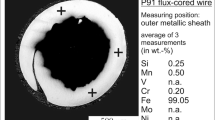Abstract
The modified 9Cr-1.5Mo-1Co steel with boron addition, designated as CB2, is one of the most promising and creep-resistant cast steels for the application in thermal power plants. To produce big cast components for steam power plants, the welding processes are an integral part of the manufacturing procedure. Therefore, an appropriate filler metal with similar properties as the base material is required. So the CB2 filler metal is target for intensive researches. In this work, creep rupture tested welding joints of rutile CB2 flux-cored wires are investigated. The objective of the paper is to compare two filler metal compositions with different nickel contents after two different creep conditions. The first comparison is concerning the creep resistance, and the second comparison is concerning the simulated microstructure with its precipitates. Differences and agreements are discussed.















Similar content being viewed by others
References
IEA (2012) World energy outlook 2012, OECD. International Energy Agency, France
Cerjak H.-H, Hofer P, Dimmler G, Kozeschnik E, Letofsky E, Pein C, Rajek HJ, Schaffernak B, Sonderegger B, Weinert P (2004) A Comprehensive Approach to the Development and Improvement of 9-12% Cr Steels - Report, Status & Outlook. - in: 4th Int. Conf. Advances in Materials Technology for Fossil Power Plants (EPRI), 1042–1063
Letofsky E (2001) Verhalten von Schweißverbindungen moderner Kraftwerkswerkstoffe; im Rahmen des europäischen Forschungsprojektes “Werkstoffe für fortschrittliche Komponenten in Hochwirkungsgrad-Niedrigemissionsenergieerzeugungssystemen” (COST501/III/WP11-A3), PhD Thesis, Graz University of Technology. VII, 354 S
Staubli M, Hanus R, Weber T, Mayer K-H, Kern T-U (2006) The European efforts in development of new high temperature casting materials, COST 536. Proceedings of the 8th Liège Conference. European Commission, Université de Liège, (Part II) 53:855–870
Mayr P, Schalber A, Letofsky E, Cerjak H.-H (2006) Weldability of boron alloyed high-temperature resistant 9% chromium casting steel COST-CB2A, International Conference on Trends in Welding Research, Proceedings of the 7th International Conference on Trends in Welding Research, Ohio USA, 299–304
Baumgartner S, Posch G, Mayr P (2012) Welding advanced martensitic creep-resistant steels with boron containing filler metal. Weld World 56:2–9
Stocker C (2002) Auswirkung der Ausscheidungskinetik auf das Kriechverhalten Mo- und B- legierter 9 % Cr-Stähle, PhD Thesis, Vienna University of Technology. VIII, 233 Bl
Letofsky E (2003) Microstructure aspects of creep resistant welded joints. Weld World Soudage Monde 47:3–8
Mayr P (2007) Evolution of microstructure and mechanical properties of the heat affected zone in B-containing 9% chromium steels. PhD dissertation thesis, Delft University of Technology
Danielsen HK, Hald J (2009) On the nucleation and dissolution process of Z-phase Cr(V, Nb)N in martensitic 12%Cr steels. Mater Sci Eng A 505:169–177
Cipolla L, Danielsen HK, Venditti D, Di Nunzio PE, Hald J, Somers MAJ (2010) Conversion of MX nitrides to Z-phase in a martensitic 12 % Cr steel. Acta Mater 58:669–679
Danielsen HK, Hald J (2004) Z-Phase in 9–12% Cr-Steels, Thermal Engineering Research Association (Värmeforsk), Stockholm. 863 M4-313, 1–47
Sonderegger B (2005) Charakterisierung der Substruktur in modernen Kraftwerkswerkstoffen mittels der EBSD Methode, PhD Thesis, Graz University of Technology. 306 S
Kozeschnik E (1997) Thermodynamische Berechnung der Phasengleichgewichte und der Ausscheidungskinetik in metallischen Werkstoffen, PhD Thesis, Graz University of Technology. 183 Bl
Kozeschnik E (2013) MATCALC, Documentation and Examples, Vienna. http://matcalc.tuwien.ac.at/index.php/documentation/doku.php?id=general. Accessed 2 Sept 2013
Kozeschnik E, Svoboda J, Radis R, Fischer FD (2010) Mean-field model for the growth and coarsening of stoichiometric precipitates at grain boundaries. Model Simul Mater Sci Eng 18, 015011
Schaffernak B (2000) Charakterisierung von 9–12 % Cr-Stählen mittels thermodynamischer Modellrechnungen, PhD Thesis, Graz University of Technology. 227 Bl.
Baumgartner S, Schuler M, Ramskogler C, Schmidtne-Kelity E, Sarić A, Schnitzer R, Lochbichler C, Enzinger N (2013) Mikrostrukturentwicklung von CB2 Fülldraht-Schweißungen, 36. Vortragsveranstaltung; Düsseldorf, am 22. 11
Dimmler G, Schalk W, Weinert P, Gruber H, Wieser S, Cerjak H (2002) Sample preparation for high-resolution damage examinations in the SEM. Prakt Metallogr 39:619–633
Streitenberger M (1991) Nichtmetallische Einschlüsse im MAG-Schweißgut. Wiss Z Technol Univ Magdeburger 35(3):26–32
Dimmler G (2003) Quantifizierung der Kriech- und Zeitstandfestigkeit von 9–12 % Cr-Stählen auf mikrostruktureller Basis, PhD Thesis, Graz University of Technology. 364 S
Povoden-Karadeniz E (2014) Thermodynamic and diffusion mobility databases mc_fe_v2.016.tdb and mc_fe_v2.001.ddb for thermokinetic precipitation simulations using MatCalc, Vienna, unpublished results
Ramskogler C (2013) KW50+ Untersuchungsbericht, 2. Forschungshalbjahr - Arbeitspakete, interne Untersuchungsdokumentation, internal, Graz. J1U1
Kozeschnik E, Rindler W, Buchmayr B (2007) Scheil-Gulliver simulation with partial redistribution of fast diffusers and simultaneous solid-solid phase transformations. Int J Mater Res 98:826–831
Acknowledgments
The authors want to thank the Austrian “Forschungsförderungsgesellschaft” (FFG) for the financial support based on the contract no. 831995.
Author information
Authors and Affiliations
Corresponding author
Additional information
Doc. IIW-2484, recommended for publication by Commission II “Arc Welding and Filler Metals.”
Rights and permissions
About this article
Cite this article
Schuler, M., Baumgartner, S., Schnitzer, R. et al. Creep investigation and simulation of CB2 joints using similar rutile CB2 flux-cored wire. Weld World 58, 903–913 (2014). https://doi.org/10.1007/s40194-014-0169-0
Received:
Accepted:
Published:
Issue Date:
DOI: https://doi.org/10.1007/s40194-014-0169-0




